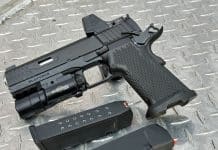In a now-infamous show of absolute ignorance and comical stupidity, California’s very own Rep. Kevin De Leon, while holding an AR-15, once said,
"This is a ghost gun. This right here has the ability with a 30-caliber clip to disperse with 30 bullets within half a second."
Well. Where can I get one of those?? I checked the local Cabela’s and nope, they didn’t have it. But a few months ago, I got to build and play and train with a modern-day ghost gun. This one still doesn’t fire 30 bullets in half a second though.
It’s a great American tradition to defy the government when it comes to firearms. Heck, the "shot heard around the world" started when the British attempted to seize a stockpile of weapons. Recently, one of the trends in modern firearms is the "80% lower," essentially an AR-15 lower receiver that still requires machining in order to become an operable part of a firearm. Generally, the 80% lower has to have a large section of metal (or plastic, crazy kids these days) machined out in order to fit certain components. These lower receivers are not firearms, and therefore, are not regulated by the government. For many gun enthusiasts, this is a hobby. These people have the time to experiment and build an AR-15, the rifle choice of bald eagles around the country, with their own hands. And I have to agree that there is something immensely gratifying about the whole process.
Last year, I was at the precursor to the upcoming TRIGGRCON event. It was a well-done industry "gun show" where many top-of-the-line companies showed off their latest and greatest creations. Not only was the show open to the public, I was amazed that the owners of many of these companies were there in person. As I’ve written about before, I have a very difficult job of playing with firearms of all sorts. It isn’t easy, but I do it as a service to you, the people. Many booths were interesting, but one of them caught my attention a little more than the rest. A company called Polymer80 was there, showing off 80% frames for Glock handguns. The polymer frames were to a Glock what an 80% lower receiver was to an AR-15.
At this particular event, Polymer80 was showing off the variety of colors that their PF940 frame came in. Naturally, I went and picked one of them up. Being designed for a Glock 17/22 full-frame handgun, the grip felt good, but still had some of that 2×4 feel of a Glock frame. Good, not great, but a novel concept that I saw a lot of potential with. I primarily shoot handguns, so the chance to build my own appealed to me in a way that AR-15 lovers look forward to building new AR rifles. The company representative struck up a friendly conversation with me, and the conversation quickly turned to carry use. I prefer a Glock 19-sized frame in the appendix position for conceal carry, as the magwell doesn’t jut out as far as a Glock 17-sized frame. The representative’s eyes lit up, and he told me that the company was in the final phases of producing a polymer 80% frame for a compact handgun.

He pulled out his phone and showed me some 3-D renderings, and a picture of a prototype model. Apparently they had everything figured out but were finalizing the last tiny quirks of the next-generation pistol frame. Now, before I describe the pistol frame in detail, one should be acquainted with the shortcomings of a factory Glock frame.
Nothing. Seriously. They work just fine. But if you want to customize your handgun, there are some ergonomic and functional changes that many in the frame-customization industry have come to view as standard.
I got a sense of Polymer80’s forward-thinking and futuristic second generation Glock frame from the picture they showed me. They had built a Glock frame designed for compact 19/23 model Glocks. They had removed the finger grooves, slightly flared the magwell, put an indexing reference under the trigger guard, cut small "accelerator cuts" into the forward portions of the frame, and for good measure even changed the mounting system to Picatinny railing. The representative told me that it would be available with their upgraded texturizing, or that you could buy the new model slick and stipple it yourself.
Now, Polymer80 had my attention. An 80% frame for a Glock 19 (my daily carry gun) with all the frame upgrades I normally either do myself or pay someone to do for me. I eagerly waited for the release date, and then one day, that release day magically came. When I went out my front door to go get my Polymer80 PF940C frame (the "C" is for compact, in case you went to public school), I accidentally stepped in unicorn poop. And the PF940C rapidly became something of a unicorn- selling out from most online distributors and retailers within the first day or two.
In the box was the frame inside of a red jig, the drill bits needed to machine sections of the pistol out, and some metal internal Glock components. The package itself was clean-cut and looked good- it spoke well about Polymer80’s care down to the final elements of presentation. I couldn’t wait.
MILLING THE PF940C
Being an 80% lower, the frame does not work with a Glock slide out of the box. There are several places that have to be machined out in order for the frame to attach to the slide. The PF940C had some instructions that recommended using a drill press to mill out the frame to adulthood. Thankfully, my friend David had a drill press and was more than happy to let me use it.
The machining process itself was simple, and relatively easy for someone with almost zero mechanical inclinations. The included directions were clear enough, but to summarize the process in words, there are 5 parts to mill out. Looking at the side of the frame, there are some ridges that prevent a slide from sitting flush with the frame, and those have to be milled out. They are both fore and aft of the trigger guard. There is a barrel block, that prevents a recoil spring from sitting in the forward section of the frame. Finally, there are holes that have to be drilled for the frame pins to sit inside the Glock and hold the internals together.
The actual machining took around 20 minutes, and I was going fairly slowly. However, my unfamiliarity with a drill press and my cautiousness meant that I spent about 45 minutes with a file to get the parts all smooth and clean. I could have saved a lot more time if I had been slightly more aggressive with the drill press, but hey, lessons learned. The hardest part for me was the barrel block- I didn’t properly set the jig in the vice grips and so the frame slipped a little. Turns out it was alright, but it made my poor heart shake. Everything else was easy. If you get one of these frames and machine it out, make sure that you make a few passes when drilling out the holes for the takedown pins- I didn’t, and now taking the frame apart requires a few curse words and a hammer to pop the pins out.

Polymer80 also makes slides that are simplistic, yet functional with forward slide serrations and a cool-looking angle cut on the corners of the slide. Naturally, I needed one. A factory Glock barrel and a parts kit (the PF940C is a Gen 3 pattern Glock) finished out the internals, and a set of fiber optic sights meant the gun was ready to go. Time to see what the little ghost gun could do.

Good thing for all of you readers, I’m borderline genius. In my great wisdom, I managed to put the slide lock in backwards, and was really frustrated with the inconsistent performance of the gun. Thankfully I have good friends who, after a good laugh at me, revealed the error of my ways and now we are all going to forget about that little incidence.
But for real- firing the second generation Polymer80 pistol felt exactly how I like my pistols to feel. Boringly reliable. The recoil impulse was exactly like that of my factory Glock 19. The gun was reliable, and ate all the rounds that I fed it. I used a variety of magazines- ETS, Magpul, Glock OEM- and each performed with that key word I want to hear when I talk about firearms: reliably. Honestly, it’s a little tough writing about a gun that performed like any other boring Glock. But that’s a good thing right?
A few key takeaways.
The second-generation Polymer80 pistol isn’t perfect. My biggest complaint about the Polymer80 pistol is that it is too wide to fit inside most Glock 19 holsters. The picatinny-style section at the front of the pistol is a little bit wider than the factory forend of the frame. Picatinny is a nice thought, but honestly, there is enough of an ecosystem built around Glock handguns that it probably wasn’t needed. And the fact that I can’t use my existing holsters is kind of a bugger, as my British friend Paul would say. Currently, I’m using a Sticky Holster for the Polymer80, and that is working quite well. I did just recently see that Clark Trost over at CNC Holsters has a Polymer80 option on his flagship Keroman V2 holster, so hopefully that means that Polymer80 guns will soon have plenty of holster options. Another issue I ran into is my aggressive handgun grip, which normally isn’t a problem on factory Glocks, would lock the slide back occasionally during shot strings. Closer examination showed that the small guard lip under the slide stop lever is a little bit smaller than on a factory Glock. This was solved by replacing the fancy extended slide stop lever with a factory slide stop lever. It didn’t seem to be an issue for other shooters, but it was worth noting.
Final Thoughts
Polymer80 scored a home run with their PF940C. When what you want from a handgun is boring reliability because it matters, Glock is the undisputed king. A review of a well-made Glock clone is inherently going to be boring, because if the gun does it’s job right then there shouldn’t be much to write home to Ma about. Polymer80 did a good job of keeping the consistency and reliability of a Glock 19/23, with a few small functional adjustments. To Glock shooters, the PF940C will feel familiar, yet slightly better than the factory Glock frame. To shooters new to Glocks, the PF940C might be enough to cease the complaining about "a Glock feels like a 2×4" in the hand. It’s clean-cut, and functional. The minor changes add up to a major win.

I have a tendency to tinker and modify my guns. But the Polymer80 gun will remain as I first got it. Clean-cut, elegant, yet simple. I’ve been happy with the gun, and pleased enough with it’s performance to make it an option for every day carry. It’s a fantastic option for someone wanting a Glock, but wants to try something a little fancier. And for the Glock user looking to add another gun to their collection, the PF940C is not only a great firearm, but a fun project that you can look at with pride and say, "I built that." Well, 20% of it.

Unfortunately though, it still doesn’t fire 30 bullets in half a second. Damn.














[…] In a now-infamous show of absolute ignorance and comical stupidity, California’s very own Rep. Kevin De Leon, while holding an AR-15, once said, “This is a ghost gun. This right here has the ability with a 30-caliber clip to disperse with 30 bullets within half a second.” Well. Where can I get one of those?? I […] …read more […]